
The Ganges Delta is a river delta in Eastern South Asia predominantly covering the Bengal region of the subcontinent, consisting of Bangladesh and the Indian state of West Bengal. It is the world's largest river delta and it empties into the Bay of Bengal with the combined waters of several river systems, mainly those of the Brahmaputra river and the Ganges river. It is also one of the most fertile regions in the world, thus earning the nickname the Green Delta. The delta stretches from the Hooghly River east as far as the Meghna River.

The Sundarbans National Park is a national park, tiger reserve and biosphere reserve in West Bengal, India. It is part of the Sundarbans on the Ganges Delta and adjacent to the Sundarban Reserve Forest in Bangladesh. It is located to south-west of the Bangladesh. The delta is densely covered by mangrove forests, and is one of the largest reserves for the Bengal tiger. It is also home to a variety of bird, reptile and invertebrate species, including the salt-water crocodile. The present Sundarban National Park was declared as the core area of Sundarban Tiger Reserve in 1973 and a wildlife sanctuary in 1977. On 4 May 1984 it was declared a national park. It is a UNESCO World Heritage Site inscribed in 1987, and it has been designated as a Ramsar site since 2019. It is considered as a World Network of Biosphere Reserve from 1989.

Sundarbans is a mangrove area in the delta formed by the confluence of the Ganges, Brahmaputra and Meghna Rivers in the Bay of Bengal. Sundarban Reserve Forest (SRF) of Bangladesh is the largest mangrove forest in the world. It spans the area from the Baleswar River in Bangladesh's division of Khulna to the Hooghly River in India's state of West Bengal. It comprises closed and open mangrove forests, land used for agricultural purpose, mudflats and barren land, and is intersected by multiple tidal streams and channels. Sundarbans is home to the world's largest area of mangrove forests. Four protected areas in the Sundarbans are enlisted as UNESCO World Heritage Sites, viz. Sundarbans West (Bangladesh), Sundarbans South (Bangladesh), Sundarbans East (Bangladesh) and Sundarbans National Park (India).

Mangrove forests, also called mangrove swamps, mangrove thickets or mangals, are productive wetlands that occur in coastal intertidal zones. Mangrove forests grow mainly at tropical and subtropical latitudes because mangroves cannot withstand freezing temperatures. There are about 80 different species of mangroves, all of which grow in areas with low-oxygen soil, where slow-moving waters allow fine sediments to accumulate.

Heritiera littoralis, commonly known as the looking-glass mangrove or tulip mangrove, is a mangrove tree in the family Malvaceae native to coastal areas of eastern Africa, Asia, Melanesia and northern Australia. The common name refers to the silvery appearance of the underside of the leaves, resembling a mirror to some degree. The strong timber has uses in marine applications and elsewhere.

Barringtonia acutangula is a species of Barringtonia native to coastal wetlands in southern Asia and northern Australasia, from Afghanistan east to the Philippines, Queensland and the Northern Territory. Common names include freshwater mangrove, itchytree and mango-pine.
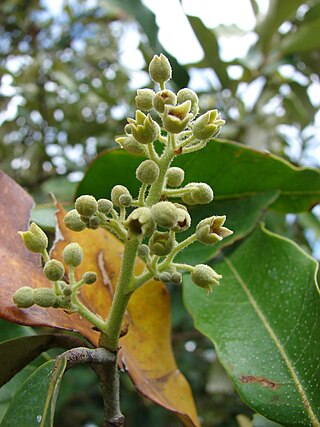
Heritiera is a genus of flowering plants in the family Malvaceae, subfamily Sterculioideae. They are most dominant tropical forest trees in several areas in eastern Africa and India to the Pacific. Some are mangroves. Several are valuable for their timber and are over-exploited.

Zeyheria tuberculosa is a species of tree in the family Bignoniaceae. It is endemic to Brazil, and is threatened by habitat loss.
An Ecologically Critical Area (ECA) is an environmental protection zone in Bangladesh. In 1995, specific areas in Bangladesh could be deemed Ecologically Critical Areas as a result of the Environmental Conservation Act.
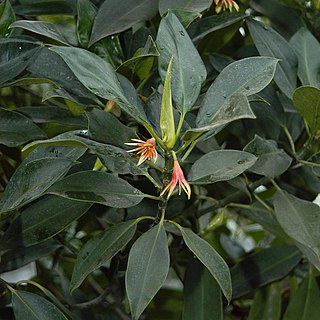
Bruguiera gymnorhiza, the large-leafed orange mangrove or oriental mangrove,) is a mangrove tree that grows usually to 7–20 metres (23–66 ft) high, but sometimes up to 35m, that belongs to the family Rhizophoraceae. It is found on the seaward side of mangrove swamps, often in the company of Rhizophora. It grows from the Western Pacific across Indian Ocean coasts to Cape Province, South Africa.

The New Guinea mangroves is a mangrove ecoregion that covers extensive areas of the coastline New Guinea, the large island in the western Pacific Ocean north of Australia.

Avicennia alba is a species of tropical mangrove in the family Acanthaceae. It is found growing in coastal and estuarine locations in India, Southeast Asia, Australia, and Oceania.
Global mangrove distributions have fluctuated throughout human and geological history. The area covered by mangroves is influenced by a complex interaction between land position, rainfall hydrology, sea level, sedimentation, subsidence, storms and pest-predator relationships). In the last 50 years, human activities have strongly affected mangrove distributions, resulting in declines or expansions of worldwide mangrove area. Mangroves provide several important ecological services including coastal stabilization, juvenile fish habitats, and the filtration of sediment and nutrients). Mangrove loss has important implications for coastal ecological systems and human communities are dependent on healthy mangrove ecosystems. This article presents an overview of global mangrove forest biome trends in mangrove ecoregions distribution, as well as the cause of such changes.

Sundarbans East Wildlife Sanctuary, a protected forest in Bangladesh, extends over an area of 31,227 ha. of mangrove forest. It was established in 1977 under the Bangladesh Wildlife (Preservation) (Amendment) Act, 1974, having previously been a forest reserve. It is the most fertile of the three, non-adjoining wildlife sanctuaries established in the Sundarbans at that time, the others being the Sundarbans West Wildlife Sanctuary and the Sundarbans South Wildlife Sanctuary. The dominant mangrove species is "sundri" from which the Sundarbans region gets its name.
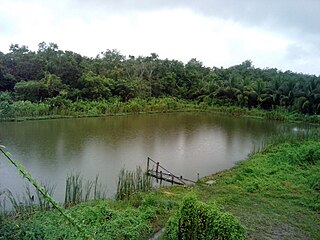
Sundarbans South Wildlife Sanctuary is a reserve forest in Bangladesh that extends over an area of 36,970 hectares of mangrove forest. It is situated next to the Sundarbans National Park in West Bengal, India. The sanctuary is one of three Sundarbans wildlife sanctuaries, the others being the Sundarbans East Wildlife Sanctuary and the Sundarbans West Wildlife Sanctuary.
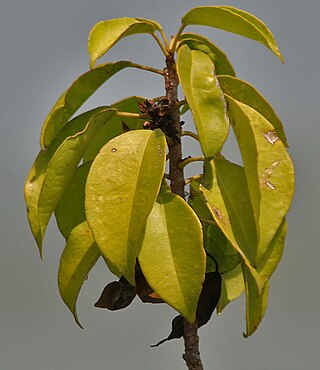
Excoecaria agallocha, a mangrove species, belongs to the genus Excoecaria of the family Euphorbiaceae. The species has many common names, including blind-your-eye mangrove, blinding tree, buta buta tree, milky mangrove, poisonfish tree, and river poison tree. Most of the names refer to its toxic properties or its propensity to cause blindness when its latex comes into contact with the eyes.
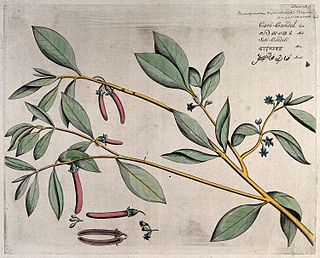
Bruguiera cylindrica is a mangrove in the family Rhizophoraceae. It grows in mangrove swamps in tropical Asia.
Top dying disease is a disease that affects Heritiera fomes, a species of mangrove tree known as "sundri", a characteristic tree of the estuarine complex of the Ganges–Brahmaputra Delta in Bangladesh and West Bengal. Although an increase in certain trace elements in the sediment deposited where these trees grow may be a factor in the incidence of the disease, its cause has not been fully established.

Thalassina anomala, known as the scorpion mud lobster, is a species of crustacean in the family Thalassinidae.
Chrysothrix septemseptata is a species of crustose lichen in the family Arthoniaceae. Found in India, it was formally described as a new species in 2006 by T.A.M. Jagadeesh Ram, H. Thorsten Lumbsch, Robert Lücking, and G.P. Sinha. The type specimen was collected in the Sundarbans Biosphere Reserve ; here it was found growing on the bark of the mangrove tree Tamarix gallica. The lichen grows as a thin lemon-yellow crust measuring 0.5–2 cm (0.2–0.8 in) in diameter, with isolated patches sometimes coalescing. It contains vulpinic acid as a major secondary chemical, and minor amounts of calycin. Chrysothrix septemseptata is only known to occur at the type locality. Other mangrove trees that it is found on include Brugruiera gymnorhiza, Heritiera fomes, and Sonneratia apetala, as well as the non-mangrove tree Casuarina equisetifolia. The specific epithet septemseptata refers to the seven septa that are characteristic of the ascospores of this lichen.

















